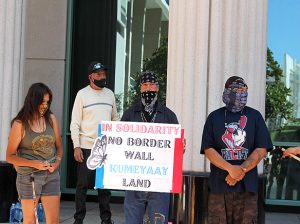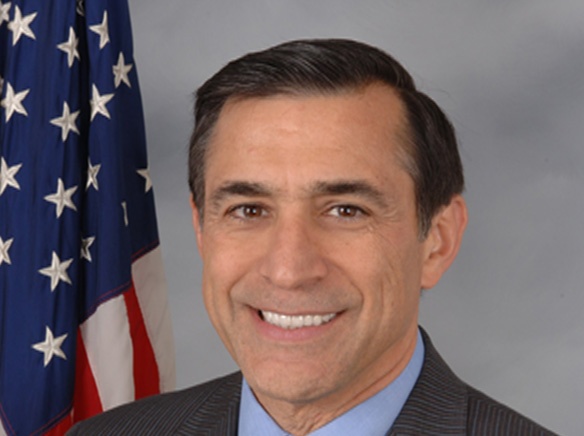
On July. 31, members and supporters of the Kumeyaay Nation gathered in front of the Hall of Justice in San Diego along with members of other tribes from as far away as Arizona and Oklahoma to protest the border wall being built on unceded land near the La Posta Reservation by the Trump administration.
The protest was just one of many that have been held downtown and at the site of the wall itself by members of the Kumeyaay Nation from Barona, Sycuan, Viejas, La Posta, Manzanita and other tribes — to varying levels of success.
Standing in the Sycuan Cultural Center a few days after the downtown protest, LaBrake connected the larger issue of the wall as a division between ancient lands that happen to sit in two modern nations to the larger challenge of economic development.
“We have reservations in Baja and the wall is a wedge. My people on the other side of the wall are Kumeyaay and this wall that is being built separates our Kumeyaay Nation,” LaBrake said.
The indigenous land LaBrake refers to stood as one stretch of land before the political boundaries of America and Mexico were established.
Sycuan Cultural Department Director Ana Gloria Rodriguez estimates there are currently about 1,000 Kumeyaay living in the four tribes located in Baja California, outside the modern American border.

If built to conclusion, the wall will effectively leave them completely cut off from the rest of the Kumeyaay Nation.
“In my opinion, we never relinquished our territory and cutting it apart is a terrible thing to do to our land, but it is also a terrible thing to do to us as a people now,” LaBrake said.
He points to a woven basket hanging in a display box and explains the basket is a teaching tool.
Traditionally, he says, a young girl would learn how to weave at the hands of older women, mothers and grandmothers who would weave life lessons into the conversation as they worked.
Similarly, he says, boys would learn how to make arrows and hunt while growing into men able and obligated to provide and protect, to walk in nature as part of a larger ecosystem.
Bringing the concepts back to the topic of the wall, he says education and cultural development were layered into ancient practices and he wants to ensure they are layered into modern life as well.
“Why are we always giving up our rights? How, in 2020, can all this economy be generated? You know, we pay taxes like the state impact on local roads, but you don’t ever see it falling back into the local communities?”
He suggests the possibility of a company with indigenous developers who work in their own communities with full cost transparency, governed by the tribe.
“You know, this wall is costing us what, $21.6 billion? How much would it cost to build in an access road? And what if you took some of the money paid to an indigenous construction company, turned around and invested it then used that profit on education and local businesses?” La Brake said.
Furthermore, he says a company run by indigenous people comprehends the importance of keeping their nation connected and could feasibly build an access road in the wall then participate in developing a identification card system that would allow tribal members to freely pass through the wall.
Essentially he describes a transportation overlay route that would allow the Kumeyaay Nation to remain connected despite the wall.
“The wall is an obstruction to life. Everything is connected,” LaBrake said.
It is not unlike what tribal leader Blue Eagle Vigil said while standing on the steps of the Hall of Justice:
“All 12 bands of the Kumeyaay Nation do a lot for their community as a whole, regardless of where they are located. It kills me to see that wall separating our lands. I see the impoverished nations out there, getting taxed to build a wall they don’t want that is going to keep them apart.”













